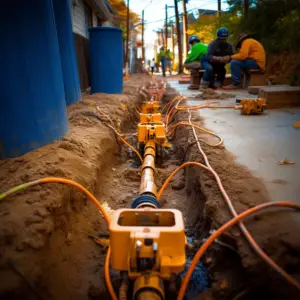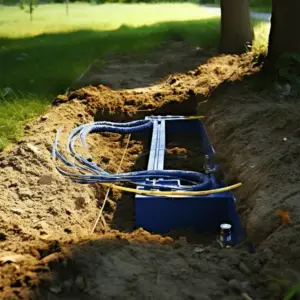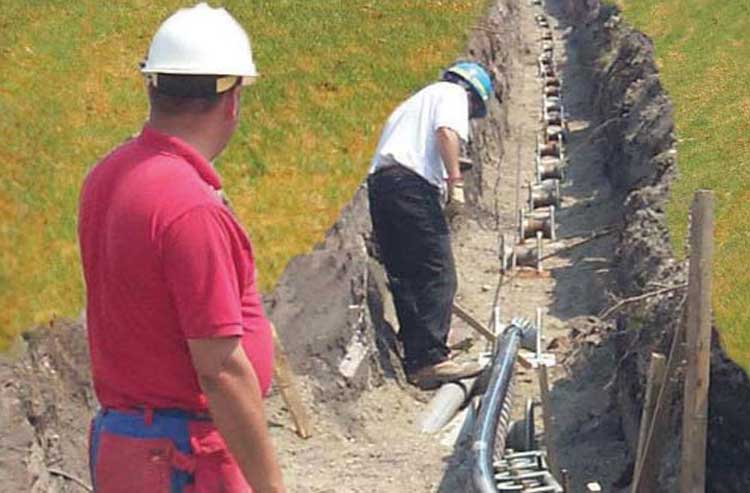Electric cable installation depth, Overhead power lines are commonly used to transmit electricity in most communities because they are easy to install and suitable. However, you may be limited by circumstances just as the overhead wiring, compelling you to use underground electrical lines.
How deep will the power cable be? The electric lines should be at least 900mm or deep or 3 feet towards the conduit. However, these measurements are not standard as there are several factors to be put into consideration.
For more details on this particular topic, read the article to the end.
Table of Contents
How Deep Are Electric Lines Buried: What Elements Should be Used to Determine it?

Underground power cables should be deep enough to be secure from any physical damage. Although requirements may vary geographically, the National Electric Code (NEC) gives the minimum guidelines based on the installation method, the cable’s type and conduit, voltage, and the physical installation features that determine the depth.
Here are some elements to consider:
Method of Installation
Direct Burial Installation
Underground wires have two ways of installation. The direct burial option is placing a multi-conductor wire with a covering that is purposely made to withstand the elements that link to soil and moisture, like corrosion.
The last measurement here is 24 inches unless it is installed underneath a concrete slab with a 2-inch thickness minimum which will require the power lines to be installed at 18 inches.
Installing In a Raceway/Conduit
If you’re using a non-metallic underground raceway option, the set depth is 18 inches minimum with the exclusion of a concrete slab that is 2 inches thick, where you can install the conduit at a depth of 12-inches. On the other hand, metallic raceways are installed at a minimum depth of 6 inches.
Location
The location plays a major role, like where you live, and the area’s landscape contributes to the requirements. For instance, solid rock may hinder you from excavating in-depth, thus restricting deeper installation; thus, the least standard is 12 inches with 2 inches when it comes to the concrete slab to protect the wire conduit.
Also, when it comes to commercial places like the airport, etc., differ from residential spaces.
Type of Conduit
The type of conduit used is metallic or PVC type conduit, although to liaise with the service provider who will not only guide you on the exact type of cables buried underneath your yard and also help you get the exact mark to avoid confusion with others like the gas or phone line cables.
Therefore, both commercial and residential installations use a PVC conduit. For metal conduit, place the lines at a minimum of 6 inches. For non-metallic PVC conduit, the cable should be at a minimum of 18 inches, or you can minimize the depth by putting a concrete cover of a suitable size.
Voltage
You require a depth of 12 inches for low voltage wires like a 120 regulated via a circuit breaker of 20 amps. For circuits transmitting less than 30 volts should be in 6 inches depth. Nonetheless, control circuits under the driveways should be buried at 18 inches.
Also, note that installation beneath the roads, highways, driveways, alleys and parking lots should be 24 inches. More than 18inches depth for underground power is needed for a residential house, and for areas with passage restrictions like airport runaways, the cables can be 18 inches.
Tip: depth can lessen in areas where wires or conduit terminate.
Overall, it is always recommendable to call the hot number 811 before digging under your house, regardless of the task or size of the project. Thus, you get to protect the underneath systems, high cost of repair, heavy penalties, and severe injuries/ death.
How to Install Underground Cables
It is paramount to seek professional assistance despite having enough knowledge and skills in power cables yet having no confidence. It is crucial to note that cable installation varies depending on your state /local code.
However, you can install the underground wires through direct burial or a specific conduit. Both share almost similar procedures to each other.
First, create a layout for the pathway of the wires on the ground using a rope or any materials to measure from the electrical source to the designated area. Secondly, dig the trench where you will bury your electrical cables until you achieve the recommended depth, considering the factors above.
Third, lay the conduit regardless of the type you are using. However, for a PVC, ensure you join with an appropriate glue attaching each PVC elbow going up and out the trench to get the cable to its designated area. Use the tape or lubricant to attach the wire’s end to suitably insert and pull the lines in the PV duct.
Finally, arrange and fix the connection in your home. However, the inspector’s report needs to avoid vital underground wiring problems.
Benefits of Using Underground Electric Cables

Elongated life expectancy
Underground wires are not exposed to external damage, unlike overhead cables, thus minimizing the outage cases.
Enhance the area’s aesthetic
The overhead cables sometimes don’t look appealing when they are improperly installed. Contrary, the buried wires look aesthetically awesome, plus they prevent the overcrowding of the building with entangled wires.
Inexpensive to Maintain
The cables have minimal maintenance costs as they are securely protected from damage and harsh environmental conditions like wings, rain storms, lighting, etc.
It Is a Safe Optional
Many electrical accidents are a result of overhead cables. Therefore, underground power lines are much safer as they are inaccessible to people and other entities. It also limits the risks of hazards and shocks.
What Two Types of Ducts Used as Conduits in Underground Wires?
Underground wires must be insulated to boost their lifespan and for safety purposes. You can get ducts within your budget, taste and type. For instance, PVC ducts are durable and waterproof.
Rigid metal Duct is coated with steel and is thick. These ducts are heavy and strong to withstand harsh temperatures. Its shortcomings are the price and not easy to install.
Conclusively, the depth required for underground wires is not fixed as there are factors like the location you are in, the method you plan to use, the size and type of cable, etc., as shown in our comprehensive write-down above. However, the standard inches are 30- 42, frozen ground at a minimum of 30 inches and other driveways need deeper digging of 42 inches. However, the NEC standards are 900mm deep or 3 feet towards the conduit. Now you can explore the underground method of electric installation.


